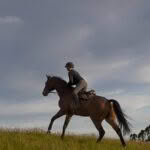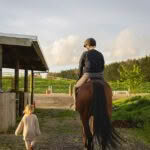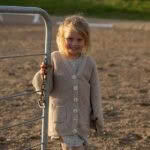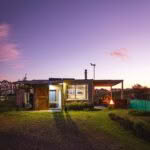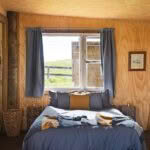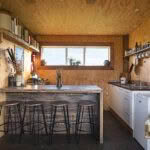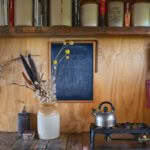Chic minimalism meets off-grid living at this couple’s home, hut and land near Taupō
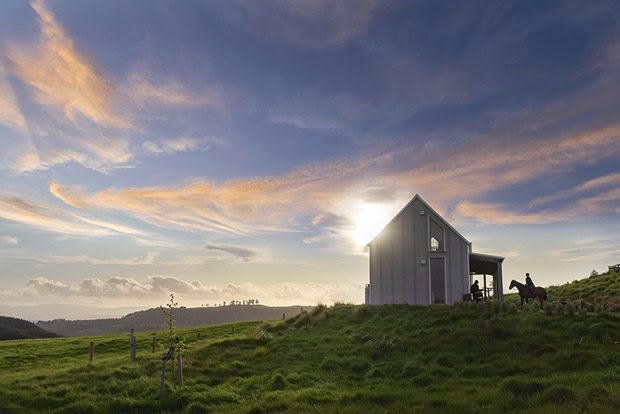
It took Brent and Chanel Griffiths a year of probing the circumference of Lake Taupō for a section bare enough to suit their limited funds. “If the land had a barn on it, it added to the price,” says Chanel. On a clear day, one can spot mountain peaks and slivers of the lake from their nine-hectare (23 acres) block near Kinloch.
Leaving Auckland for a bare Taupō block prompted a young couple to build an unfussy life from total scratch, savouring every moment.
Words: Cari Johnson Photos: Tessa Chrisp
Few children enjoy speaking candidly about earthworks and broody hens. Four-year-old Frankie Griffiths is not like most children. One minute she plays with dolls; the next, she gathers fresh eggs or helps herd a (blissfully unaware) cow before the truck arrives. Should her unicorns ever lose their lustre, Frankie knows there’s magic aplenty at her parents’ nine-hectare block near Kinloch, Lake Taupō’s most northerly hamlet.
This also was the conclusion of her parents, Brent and Chanel Griffiths, when moving to the then-bare section from Auckland in 2017. There wasn’t even one tree. Its magic was bridled only by pumice soil and the limits of their imagination. What was meant to be would happen — and it did.
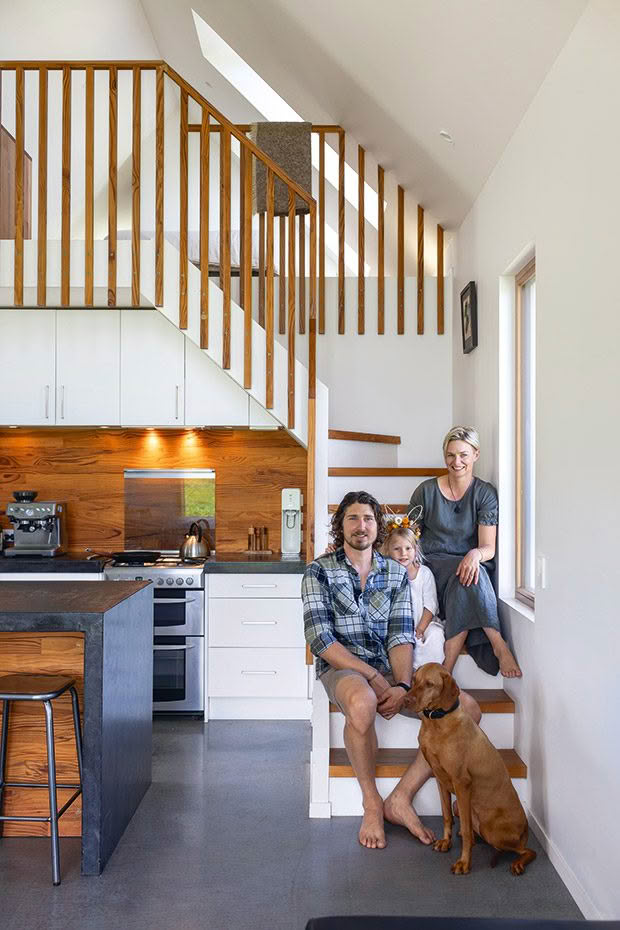
Brent and Chanel’s home atop the highest hill on their land is just big enough for their family of four. The adults sleep in the loft while the four-year-olds share the main floor — Frankie in the only doored bedroom and hungarian vizsla Betty in the lounge.
Pregnancy hadn’t exactly been part of the year-one plan. “I remember thinking, ‘Holy shit. We’re moving to Taupō with no family and no house.’ But if we didn’t do it then, we never would’ve left Auckland,” says Brent.
Brent and Chanel did have one small trick up their sleeve. Kawakawa Hut — not that it was cute-name-worthy at the time. Before ditching Auckland, the pair had driven down to Taupō for months to prepare a space to store tools, maybe even in which to sleep. It was a rumpty studio-sized thing, mainly three walls and a roof to protect Blueberry, their 1967 Crusader caravan, from winter’s pelting rain and high winds. Smaller than the average tiny house, Kawakawa Hut was only ever intended for two.
There’s nothing like impending parenthood to giddy up a timeline. Chanel recalls fastening screws on a lean-to roof while heavily pregnant; her father raced down from Coatesville to pluck said screws from her hands. By the time Frankie was born, they had fresh water tapped from the neighbour’s bore, solar-powered electricity and a beautiful barn to house materials for Brent’s next colossal project — their forever home.
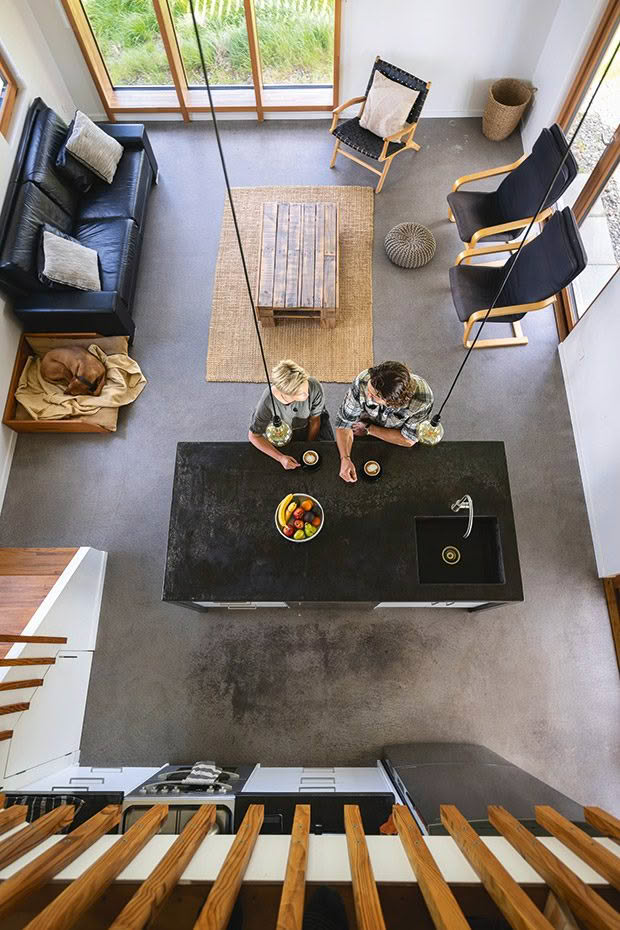
When money got tight, Facebook smiled upon Chanel when she stumbled upon a deal of lifetime — two trailer-loads of mixed timber for only $100. Brent ripped down douglas fir floor planks and laminated them to create many wooden fixtures, including the kitchen splashback, bench kickboard and the banister. He also attempted his first-ever concrete furnishings that resulted in the kitchen and bathroom benches.
Cramped quarters aside, the trio had everything and more. Not to worry that the house was at least six months away — Brent and Chanel don’t let their happiness hinge on what-ifs and could-have-beens. “We chose this lifestyle to enjoy the present and the process. Life is now, not sometime later,” says Brent.
In fact, had it not been for Brent’s pursuit of the present back in Auckland, the pair might not have left the mighty metropolis. He was once as city-slick as they come, raised in Māngere Bridge, an Auckland Grammar School old-boy. Chanel can attest he wasn’t always a workaholic, at least not when she met him in a group project at Massey University. “Apparently,” she explains, “I rolled my eyes at him.”
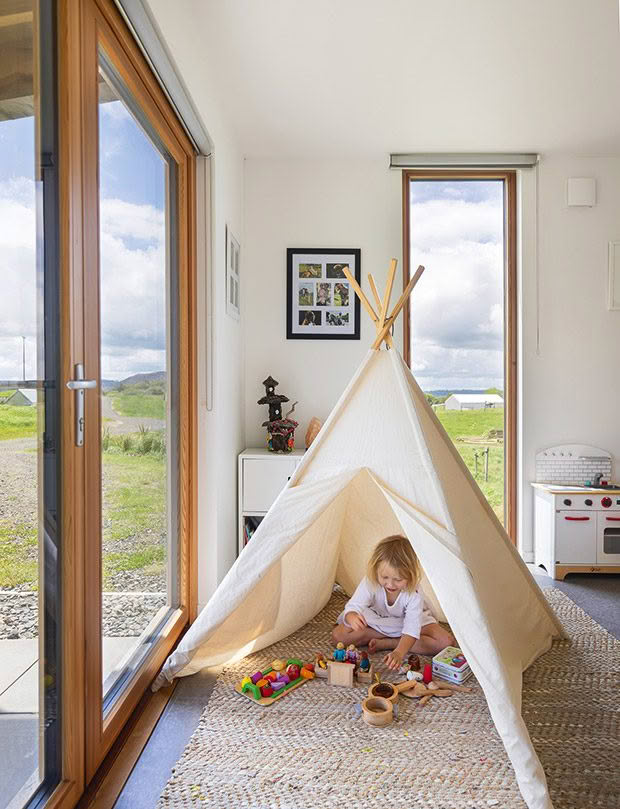
Chanel’s mum Deidre crafted the teepee for her granddaughter Frankie from scratch.
Auckland whipped her future husband into shape, all right. Long hours and commutes formed the backbone of his civil-engineering career, starting with construction and project-management jobs. Chanel worked at home as a self-employed graphic designer while Brent commuted from Coatesville to jobs mostly south of the city. (She reckons the 90-minute commute to Pōkeno finally killed his big-city buzz.) “Once you’re in a career, there’s so much pressure to keep grinding away at it. It felt like my body was half an hour behind my head,” says Brent.
Something had to give — and give it did when he stumbled on the book Boundless by entrepreneur-turned-monk Greg Hopkinson. The true story of a frazzled, overworked man finding solace through meditation resonated with Brent so much that he enrolled in the same meditation course (the Bright Path Ascension) the next weekend.
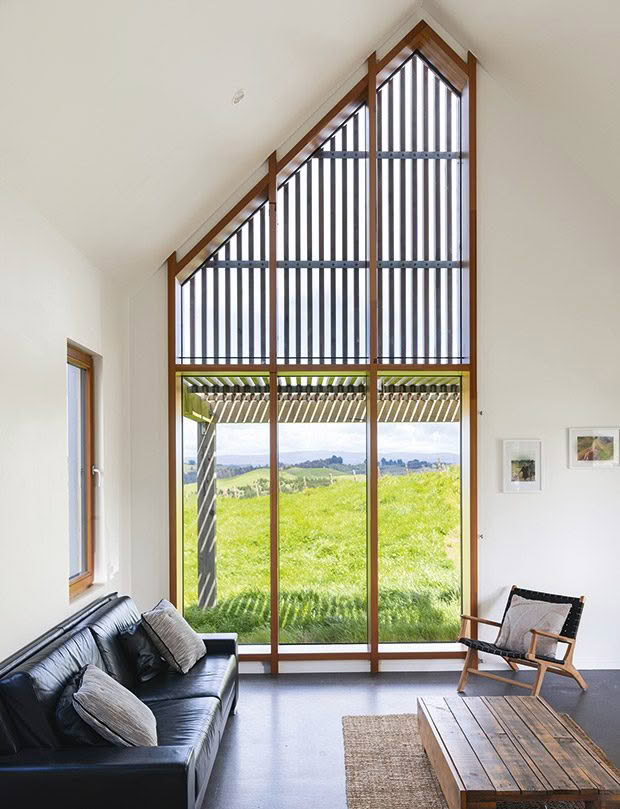
After living in their home for two summers, they added the wooden shading battens to the curtain-wall window to reduce heat gain.
It’s been his twice-daily ritual ever since. “As soon as I meditate, paths open up in a way where I don’t have to make decisions. They just happen. It allows thoughts and emotions to roll off you like water off a duck’s back,” he says.
Looking back, Brent and Chanel doubt they’d have bought their one-way ticket to the countryside without the grounding principles of meditation. After all, purchasing a bare block is a long-haul deal with plenty of stressy stopovers. “If we hadn’t had Ascension, there would have been too many things to worry about,” she says.
Brent took 18 months off work to finish the hut, dig a snake-like driveaway across their land and build their passive home. His sabbatical (of sorts) was partly funded by the sale of a house in Waimauku and Chanel’s postpartum reluctance to step back from her remote graphic-design business, Designed by CCC. Hard yakka wasn’t foreign to them — they loved it.
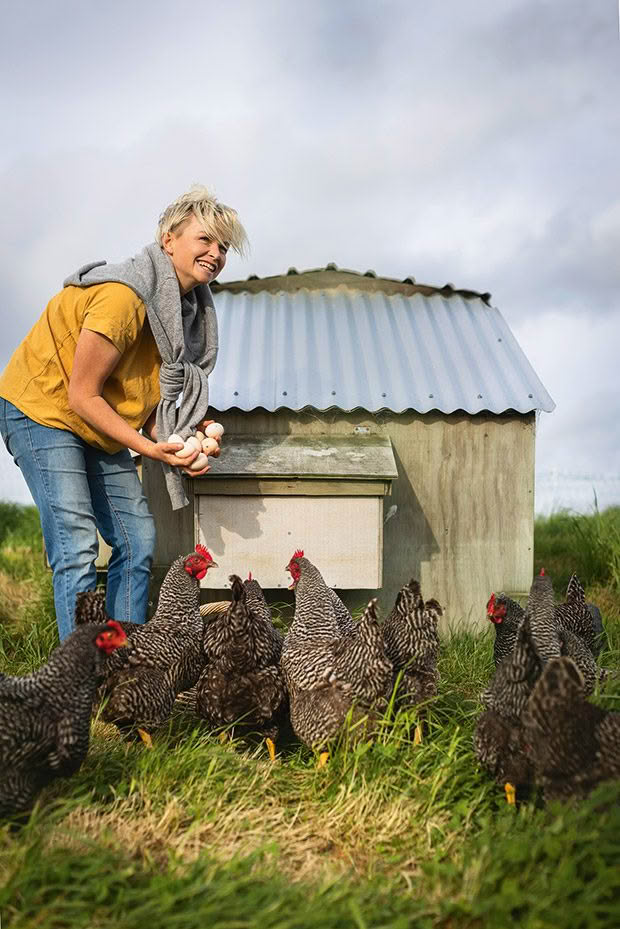
“Rather than working hard until we retire at 65 and then living our lives, we chose to go against the grain. We are working hard, but differently,” says Chanel.
“The city can easily become all about work, making more money, and keeping up with your mates by spending it. It can turn into a cycle unless you notice it and learn the tools to let go,” says Brent.
Today, he enjoys the soil beneath his bare feet and television-less hours lit up by Frankie and their sunny, curtainless home. In 2022, he resigned from Taupō’s branch of the global engineering firm WSP for a more flexible role as dad, gardener, fencer and builder of their property and neighbourhood projects. He can thank the Taupō grapevine for the latter.
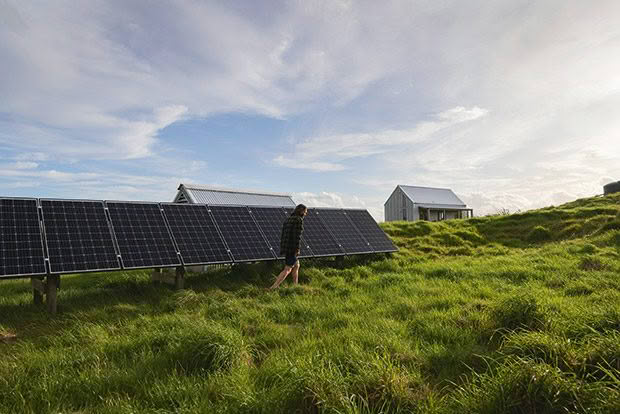
On sunny days, the small home is powered entirely by a modest three-kilowatt solar-panel set. When faced with overcast weather for two or more days, a petrol-powered generator keeps the lights on and appliances running and recharges the solar batteries (which can get them through another two days without sun). “It was going to cost $30,000 to get a power cable to the house — it wasn’t an easy connection. So, instead, we thought we might as well put $30,000 towards solar panels,” says Chanel.
“We can say yes to opportunities by living less structured. With this lifestyle, Brent can go hunting in the middle of the week, and I can ride my horse,” says Chanel.
Horse riding wasn’t the same in Coatesville, where she grew up. Fast-moving cars kept her arena-bound and off to eventing around the North Island. In fact, it was her wide circle of “horse people” that kicked off her business when she was only 25. “Back then, I could link almost every job back to a horse,” says Chanel.
Though the equestrian still competes, winning doesn’t have the same zing now that she’s a mother. “I don’t care if I win as long as I come home to Brent and Frankie,” she says.
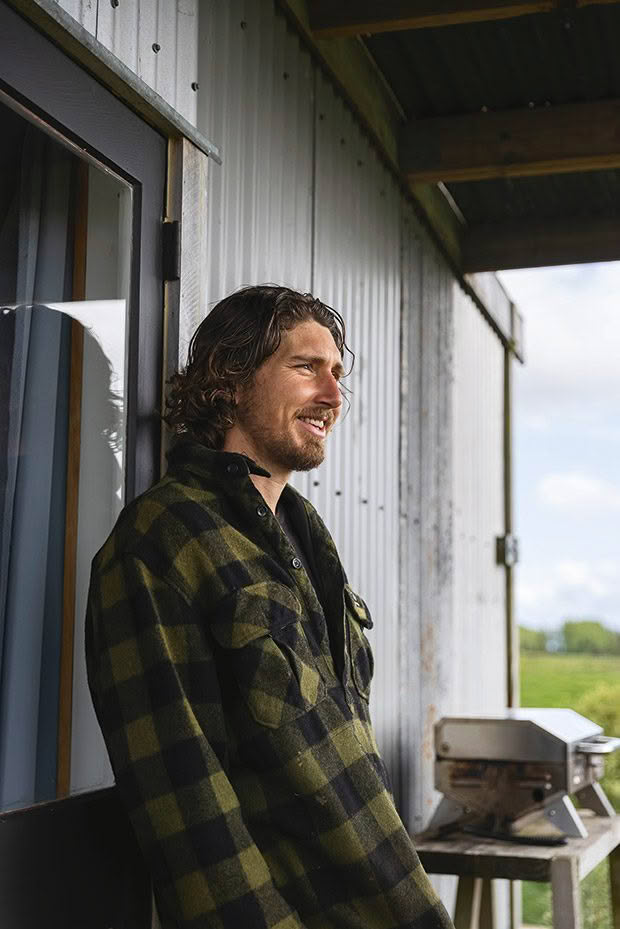
It’s a grounding life that feeds their spirit as much as their bellies. The Griffiths mostly eat homekill they’ve raised, or deer Brent has hunted, eggs from their barred rock flock and whatever can be scavenged from the garden and greenhouse. Hen whisperer Chanel has pardoned the chickens from their dinner plates for now. “I love them too much,” she says.
No, Brent and Chanel are not experienced farmers, but this quiet hinterland knows how to keep a secret. It’s as if the menagerie of cows, chickens, lambs and Chanel’s horse has allied to let the reformed urbanites laugh through their mistakes in peace. Even Betty, the deer-hunting dog, has forgiven Brent for the strict six-month training she tolerated as a puppy. Today, she acts as his nose and ears while they hunt for venison in the nearby Pureora and Kaimanawa Forests.
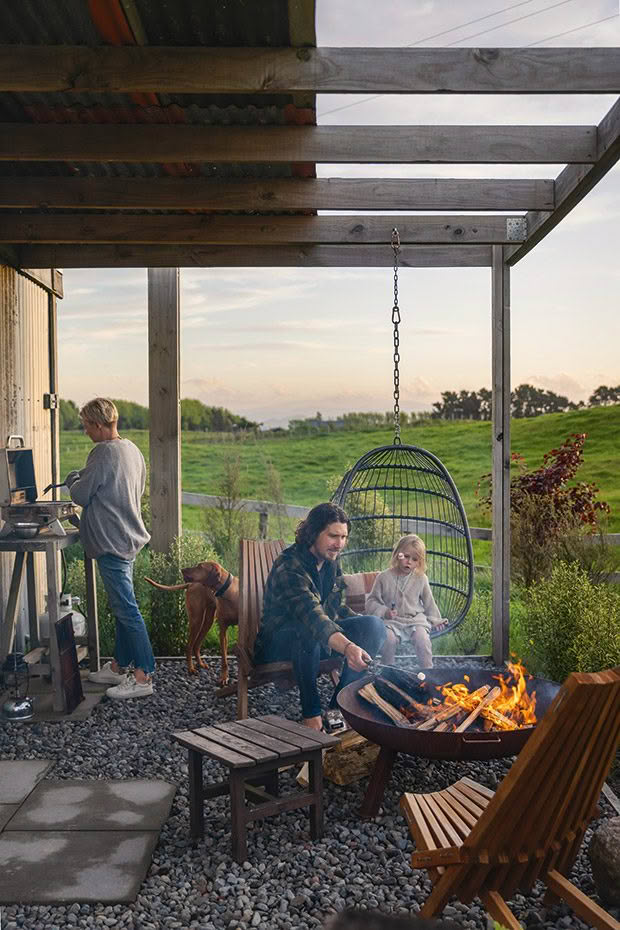
Though Brent and Chanel sold Blueberry, the 1967 Crusader caravan (she was too old, and they were too busy), her barbecue lives on at Kawakawa Hut. It didn’t take much to craft a sunset-worthy backdrop outside the hut: some river stones, knock-off designer chairs from Trade Me, and some bushy plantings (for privacy) did the trick.
And what of the wee hut? “It almost became a man cave,” says Chanel, who noticed her husband’s damp hunting clothes had colonized the hut once they moved into their home. His smelly clothes got the boot, and in went memorabilia, cosy linens and a palette of natural tones. Kawakawa Hut opened for business in 2020.
They have cleared much of their mortgage in four years, and the hopeful sale of their four-hectare subdivision will help sow their next adventure — a market garden and orchard. Currently, the orchard is in the form of fruit trees Brent and Chanel give each other for every special occasion.
- Chanel won a 50 per cent share of her warmblood-thoroughbred horse, thanks to Astek Stud, through an NZ Horse & Pony magazine promotion.
- Later, she got another 25 per cent after being named the 2015 National Young Horse Eventing Champion. She now owns 13-year-old Gymy (sired by Gym Bello) outright, along with her own arena.
- “In Taupō, you can just scrape off the topsoil to get pumice, so the arena only cost us $5000 to make. In Auckland, that would have been more like $100,000.”
“It’s always on our mind that we are creating something for Frankie. It’s our sanctuary now, but it will become even more of a sanctuary for her,” says Chanel.
“Even if she doesn’t choose this life,” says Brent, “she’ll know how to sow seeds and grow her food. And she already knows how to skin and clean a rabbit.”
KAWAKAWA HUT
- Almost everything in Kawakawa Hut (except for the plywood and wooden posts) was gifted, built by the Griffiths or scavenged. “Aesthetically, it kind of made itself,” says Chanel.
- The bedside tables came from a felled kānuka tree at their favourite hunting block in Whanganui. Chanel’s mum knitted the bed runner after her daughter fell in love with a similar style at Città.
- The kitchen bench was one of their few large possessions that made the cut from Auckland, which they fashioned out of old pallets and beer crates.
- A collection of antique stoneware jars gifted by Chanel’s father, Grant. “He was a real hoarder,” she says.
After moving into their passive home, Brent and Chanel Griffiths’ off-grid 30-square-metre hut seemed too cute to waste on Brent’s collection of
not-quite-as-cute hunting gear. In 2020, the couple finished guest-proofing the place with a comfy queen-sized bed (the secret is a mattress topper), solar-powered USB chargers, cabin-chic trimmings, and an outdoor fireplace for toasty sunsets overlooking the paddocks and veggie garden.
“I didn’t know if it would be any good. We just gave it a go,” says Chanel, who whipped up the hut-silhouetted logo and website (kawakawahut.com) in a flash.
Pretty trimmings aside, the hut is a back-to-basics experience — there is no wifi (gasp!), and guests must be able to start a fire to get the log burner roaring. Taupō is a 25-minute drive away, Kinloch a five-minute one, and the Kawakawa section of the Great Lake Trails begins just down the road. kawakawahut.com
WHAT IS A PASSIVE HOUSE?
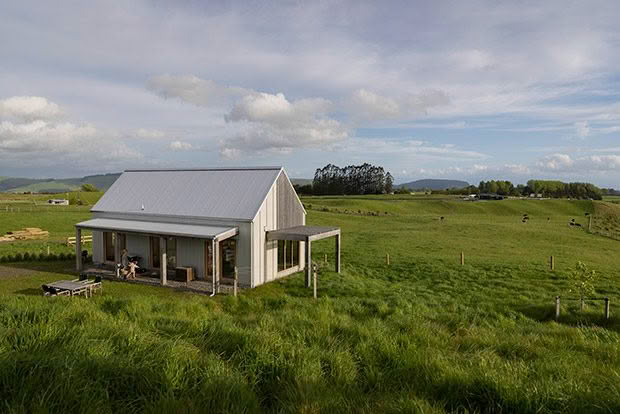
Small homes require clever décor, so the couple found inspiration in Small House Living by Catherine Foster. It steered them towards the airy and bright effects of Scandi minimalism with natural-blonde wooden accents, such as siberian larch joinery from Mosgiel’s ThermaDura.
A passive home, popular in Germany and Scandinavia, is an ultra-insulated, nearly airtight building primarily heated by passive gain. Brent and Chanel knew they wanted a quality, solar-powered home but hadn’t heard of the concept until an architectural friend-of-friend tipped them off. Jessica Eyers, of Wānaka-based firm Hiberna, designed the 93-square-metre plan (63 square metres on the ground floor, 30 square metres in the loft), which was then built over nine months almost entirely by Brent and Chanel’s father, Grant.
Ventilation modules in each room keep the air fresh, but the real wow factor is how the home stays at just the right temperature — sans heating or air-con. Triple-glazed windows, airtight door seals and a precisely angled pergola keep the house shaded in summer and invite sunlight come winter.
“We don’t need any heating in winter. You almost have to feel it to believe it. People who stay are often pleasantly surprised,” says Chanel.
Love this story? Subscribe now!
 This article first appeared in NZ Life & Leisure Magazine.
This article first appeared in NZ Life & Leisure Magazine.
